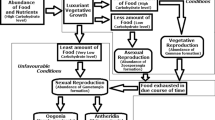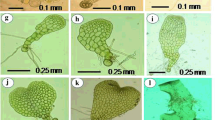Abstract
Asplenium auritum Sw. is a sexual fern that produces 64 spores per sporangium, while A. monodon Liebm. is an apogamous species that produces 32 spores. The hybrid between them, A. × lellingerianum Sánchez & Regalado, also shows an apogamous life cycle, with mainly abortive spores. The scope of this work was to study the sexual and apogamous behavior in these taxa. We studied spore germination and gametophyte development of the three species, a process that followed the Adiantum type. Afterward, we observed morphological apogamous characters in A. monodon and A. × lellingerianum. Apogamous sporophytes arose from apical and basal regions of gametophytes, lacking feet and roots in the first instance, but developing other normal sporophytic structures, such as tracheids, stomata, glandular hairs, and scales. Finally, we studied the gametangia production in all three taxa, finding that the scarce production of antheridia in A. monodon is indicative of the Braithwaite apogamous life cycle scheme, and this scheme has probably been inherited by A. × lellingerianum.








Similar content being viewed by others
References
Adams DC (1995) Asplenium. In: Davidse G, Sousa M, Knapp S (eds) Flora Mesoamericana vol. 1, Psilotaceae a Salviniaceae. Universidad Nacional Autónoma de México, México D.F., pp 234–290
Atkinson LR, Stokey AG (1964) Comparative morphology of the gametophyte of homosporous ferns. Phytomorphology 14:51–71
Barrington DS, Haufler CH, Werth CR (1989) Hybridization, reticulation, and species concepts in the ferns. Am Fern J 79(2):55–64
Bell PR, Richards BM (1958) Induced apospory in polypodiaceous ferns. Nature 182:1748–1749
Braithwaite AF (1964) A new type of apogamy in ferns. New Phytol 63:293–305
Braithwaite AF (1986) The Asplenium aethiopicum complex in South Africa. Bot J Linn Soc 93:343–378
Döpp W (1939) Cytologische und genetische Untersuchungen innerhalb der Gattung Dryopteris. Planta 29:481–533
Dyer A (1979) The culture of fern gametophytes for experimental investigation. In: Dyer A (ed) The experimental biology of ferns. Academic Press, London, pp 254–305
Edwards ME, Miller JH (1972) Growth regulation by ethylene in fern gametophytes III. Inhibition of spore germination. Am J Bot 59:458–465
Evans AM (1969) Interspecific relationships in the Polypodium pectinatum–plumula complex. Ann Missouri Bot Gard 55:193–293
Farrar DR, Dassler C, Watkins JE, Skelton C (2008) Gametophyte ecology. In: Ranker TA, Haufler CH (eds) The biology and evolution of ferns and lycophytes. Cambridge University Press, Cambridge
Gastony GJ, Windham MD (1989) Species concepts in pteridophytes: the treatment and definition of agamosporous species. Am Fern J 79(2):65–77
Jarrett FM, Manton I, Roy SK (1968) Cytological and taxonomical notes on a small collection of living ferns from Galapagos. Kew Bull 22:475–480
Lovis JD (1973) A biosystematic approach to phylogenetic problems and its application to the Aspleniaceae. Bot J Linn Soc 67:211–228
Manton I (1950) Problems of cytology and evolution in the Pteridophyta. Cambridge University Press, Cambridge
Mickel JT, Beitel JM (1988) Pteridophyte flora of Oaxaca, Mexico. Mem New York Bot Gard 46:1–568
Mickel JT, Smith AR (2004) The pteridophytes of Mexico. Mem New York Bot Gard 88:72–132
Morton CV, Lellinger DB (1966) The Polypodiaceae subfamily Asplenioideae in Venezuela. Mem New York Bot Gard 15:1–49
Morzenti VM (1966) Morphological and cytological data on southeastern United States species of the Asplenium heterochroum–resiliens complex. Am Fern J 56(4):167–177
Morzenti VM (1969) Apomixis in ferns with special reference to sterile hybrids. Ph.D. Dissertation, University of Michigan, Michigan
Murakami M, Iwatsuki K (1983) Observations on the variation of Asplenium unilaterale in Japan with special reference to apogamy. J Jpn Bot 58(9):257–262
Nayar BK, Kaur S (1969) Types of prothallial development in homosporous ferns. Phytomorphology 19:171–188
Nayar BK, Kaur S (1971) Gametophytes of homosporous ferns. Bot Rev 37(3):295–396
Proctor GR (1977) Flora of Lesser Antilles, Leeward and Windward Islands. Vol 2. Pteridophyta. Arnold Arboretum, Harvard University, Jamaica Plain
Proctor GR (1985) Ferns of Jamaica. British Museum (Natural History), London
Raghavan V (1989) Developmental biology of fern gametophytes. Cambridge University Press, Cambridge
Regalado L, Sánchez C (2001) Problemática del complejo Asplenium auritum Sw. (Aspleniaceae: Pteridophyta) y especies afines en Cuba. Rev Jard Bot Nac Univ Habana 22(1):7–28
Regalado L, Sánchez C (2002) Spore morphology as a taxonomic tool in the delimitation of three Asplenium L. species complexes (Aspleniaceae: Pteridophyta) in Cuba. Grana 41:107–113
Sánchez C, Regalado L (2003) Aspleniaceae. In: Greuter W (ed) Flora de la República de Cuba, vol 8(1). Taunus, Königstein, pp 3–65
Smith AR (1981) Pteridophytes. In: Breedlove DE (ed) Flora of Chiapas; part 2. California Academy of Sciences, San Francisco, pp 1–370
Soare LC, Vişoiu E, Andrei M (2007) Researches concerning the in vitro differentiation of the fern Phegopteris connectilis (Michx.) Watt. Notul Bot Hort Agrobot Cluj-Napoca Inst 35(1):7–14
Steil WN (1933) New cases of apogamy in certain homosporous leptosporangiate ferns. Bot Gaz 95:164–167
Steil WN (1939) Apogamy, apospory, and parthenogenesis in pteridophytes. Bot Rev 5:433–453
Steil WN (1951) Apogamy, apospory, and parthenogenesis in pteridophytes II. Bot Rev 17:90–104
Stolze RG (1981) Ferns and fern allies of Guatemala II. Polypodiaceae. Fieldiana Bot 6:59–95
Stolze RG (1986) Polypodiaceae–Asplenioideae. In: Harling G, Sparre B (eds) Flora de Ecuador. Department of Systematic Botany, University of Göteberg, Göteberg, pp 1–83
Tryon AF (1968) Comparison of sexual and apogamous races in the fern genus Pellaea. Rhodora 70:1–24
Tryon RM, Stolze RG (1993) Pteridophyta of Peru. Part V. 18. Aspleniaceae–21. Polypodiaceae. Fieldiana Bot 32:1–49
Wagner WH (1963) A byosystematic survey of United States ferns—preliminary abstracts. Am Fern J 53(1):1–16
Walker TG (1966) A cytotaxonomic survey of the pteridophytes of Jamaica. Trans R Soc Edinburgh 66:169–237
Walker TG (1979) The cytogenetics of ferns. In: Dyer AF (ed) The experimental biology of ferns. Academic Press, London, pp 87–132
Walker TG (1985) Cytotaxonomic studies of the ferns of Trinidad. 2. The cytology and taxonomic implications. Bull Brit Mus (Nat Hist) Bot 13(2):149–249
Whittier DP (1966) Induced apogamy in diploid gametophytes of Pteridium. Can J Bot 44:1717–1721
Whittier DP (2004) Induced apogamy in Tmesipteris (Psilotaceae). Can J Bot 82(6):721–725
Whittier DP, Steeves TA (1960) The induction of apogamy in the bracken ferns. Can J Bot 38:925–930
Whittier DP, Steeves TA (1962) Further studies on the induction of apogamy in ferns. Can J Bot 40:1525–1531
Acknowledgments
Authors are grateful to an anonymous reviewer for the valuable comments and suggestions, which greatly improved the manuscript, and also to William Clarke for the English review. This research was supported by the Agreement of Cooperation between Universidad Complutense de Madrid, Spain, and Agencia de Medio Ambiente, Cuba, which funded two stays for the first author at the Departamento de Biología Vegetal I, Universidad Complutense de Madrid.
Author information
Authors and Affiliations
Corresponding author
Rights and permissions
About this article
Cite this article
Regalado Gabancho, L., Prada, C. & Gabriel y Galán, J.M. Sexuality and apogamy in the Cuban Asplenium auritum–monodon complex (Aspleniaceae). Plant Syst Evol 289, 137–146 (2010). https://doi.org/10.1007/s00606-010-0339-5
Received:
Accepted:
Published:
Issue Date:
DOI: https://doi.org/10.1007/s00606-010-0339-5




